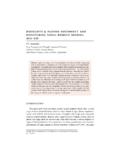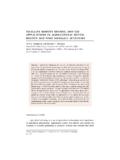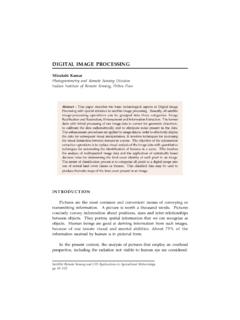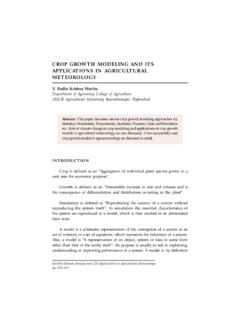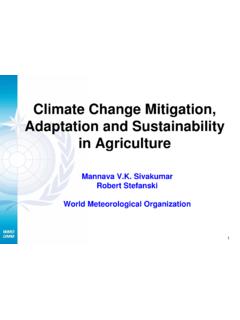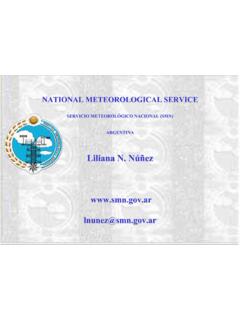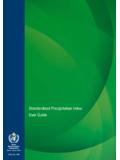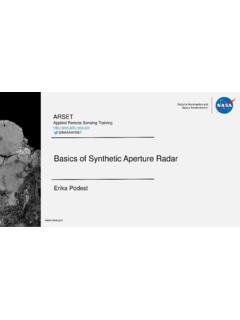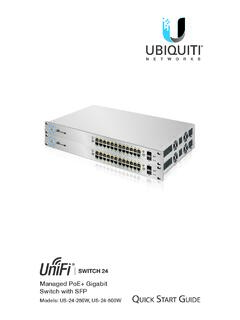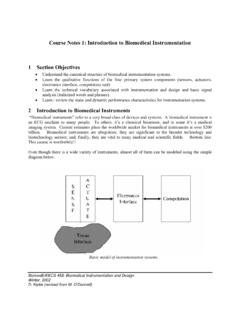Transcription of PRINCIPLES OF REMOTE SENSING - wamis.org
1 PRINCIPLES OF REMOTE SENSINGS hefali AggarwalPhotogrammetry and REMOTE SENSING DivisionIndian Institute of REMOTE SENSING , Dehra DunAbstract : REMOTE SENSING is a technique to observe the earth surface or theatmosphere from out of space using satellites (space borne) or from the air usingaircrafts (airborne). REMOTE SENSING uses a part or several parts of theelectromagnetic spectrum. It records the electromagnetic energy reflected or emittedby the earth s surface. The amount of radiation from an object (called radiance) isinfluenced by both the properties of the object and the radiation hitting the object(irradiance). The human eyes register the solar light reflected by these objects andour brains interpret the colours, the grey tones and intensity variations. In remotesensing various kinds of tools and devices are used to make electromagnetic radiationoutside this range from 400 to 700 nm visible to the human eye, especially thenear infrared, middle-infrared, thermal-infrared and SENSING imagery has many applications in mapping land-use and cover,agriculture, soils mapping, forestry, city planning, archaeological investigations,military observation, and geomorphological surveying, land cover changes,deforestation, vegetation dynamics, water quality dynamics, urban growth, etc.
2 Thispaper starts with a brief historic overview of REMOTE SENSING and then explains thevarious stages and the basic PRINCIPLES of remotely sensed data collection SENSING (RS), also called earth observation, refers to obtaininginformation about objects or areas at the Earth s surface without beingin direct contact with the object or area. Humans accomplish this task withaid of eyes or by the sense of smell or hearing; so, REMOTE SENSING is day-to-day business for people. Reading the newspaper, watching cars driving in frontof you are all REMOTE SENSING activities. Most SENSING devices record informationabout an object by measuring an object s transmission of electromagnetic energyfrom reflecting and radiating REMOTE SENSING and GIS Applications in Agricultural Meteorologypp. 23-3824 PRINCIPLES of REMOTE SensingRemote SENSING techniques allow taking images of the earth surface invarious wavelength region of the electromagnetic spectrum (EMS).
3 One of themajor characteristics of a remotely sensed image is the wavelength region itrepresents in the EMS. Some of the images represent reflected solar radiationin the visible and the near infrared regions of the electromagnetic spectrum,others are the measurements of the energy emitted by the earth surface in the thermal infrared wavelength region. The energy measured in themicrowave region is the measure of relative return from the earth s surface,where the energy is transmitted from the vehicle itself. This is known as activeremote SENSING , since the energy source is provided by the REMOTE sensingplatform. Whereas the systems where the REMOTE SENSING measurementsdepend upon the external energy source, such as sun are referred to as passiveremote SENSING OF REMOTE SENSINGD etection and discrimination of objects or surface features means detectingand recording of radiant energy reflected or emitted by objects or surfacematerial (Fig.)
4 1). Different objects return different amount of energy in differentbands of the electromagnetic spectrum, incident upon it. This depends onthe property of material (structural, chemical, and physical), surface roughness,angle of incidence, intensity, and wavelength of radiant REMOTE SENSING is basically a multi-disciplinary science which includesa combination of various disciplines such as optics, spectroscopy, photography,computer, electronics and telecommunication, satellite launching etc. All thesetechnologies are integrated to act as one complete system in itself, known asRemote SENSING System. There are a number of stages in a REMOTE Sensingprocess, and each of them is important for successful in REMOTE SENSING Emission of electromagnetic radiation, or EMR (sun/self- emission) Transmission of energy from the source to the surface of the earth, as wellas absorption and scattering Interaction of EMR with the earth s surface: reflection and emission Transmission of energy from the surface to the REMOTE sensor Sensor data outputShefali Aggarwal25 Data transmission, processing and analysisWhat we seeAt temperature above absolute zero, all objects radiate electromagneticenergy by virtue of their atomic and molecular oscillations.
5 The total amountof emitted radiation increases with the body s absolute temperature and peaksat progressively shorter wavelengths. The sun, being a major source of energy,radiation and illumination, allows capturing reflected light with conventional(and some not-so-conventional) cameras and basic strategy for SENSING electromagnetic radiation is clear. Everythingin nature has its own unique distribution of reflected, emitted and absorbedradiation. These spectral characteristics, if ingeniously exploited, can be usedto distinguish one thing from another or to obtain information about shape,size and other physical and chemical REMOTE SENSING Technology versus Conventional Aerial PhotographyThe use of different and extended portions of the electromagneticspectrum, development in sensor technology, different platforms for remotesensing (spacecraft, in addition to aircraft), emphasize on the use of spectralinformation as compared to spatial information, advancement in imageprocessing and enhancement techniques, and automated image analysis inaddition to manual interpretation are points for comparison of conventionalaerial photography with modern REMOTE SENSING 1.
6 REMOTE SENSING processBuilt-up AreaSunDistribute for AnalysisPre-Process and ArchiveSatelliteReflectedSolar RadiationForestGrassWater Bare SoilPaved RoadAtmosphereDown Link26 PRINCIPLES of REMOTE SensingDuring early half of twentieth century, aerial photos were used in militarysurveys and topographical mapping. Main advantage of aerial photos has beenthe high spatial resolution with fine details and therefore they are still usedfor mapping at large scale such as in route surveys, town planning,construction project surveying, cadastral mapping etc. Modern REMOTE sensingsystem provide satellite images suitable for medium scale mapping used innatural resources surveys and monitoring such as forestry, geology, watershedmanagement etc. However the future generation satellites are going to providemuch high-resolution images for more versatile OVERVIEWIn 1859 Gaspard Tournachon took an oblique photograph of a small villagenear Paris from a balloon.
7 With this picture the era of earth observation andremote SENSING had started. His example was soon followed by other peopleall over the world. During the Civil War in the United States aerialphotography from balloons played an important role to reveal the defencepositions in Virginia (Colwell, 1983). Likewise other scientific and technicaldevelopments this Civil War time in the United States speeded up thedevelopment of photography, lenses and applied airborne use of thistechnology. Table 1 shows a few important dates in the development of next period of fast development took place in Europe and not in theUnited States. It was during World War I that aero planes were used on alarge scale for photoreconnaissance. Aircraft proved to be more reliable andmore stable platforms for earth observation than balloons. In the periodbetween World War I and World War II a start was made with the civilianuse of aerial photos.
8 Application fields of airborne photos included at thattime geology, forestry, agriculture and cartography. These developments leadto much improved cameras, films and interpretation equipment. The mostimportant developments of aerial photography and photo interpretation tookplace during World War II. During this time span the development of otherimaging systems such as near-infrared photography; thermal SENSING and radartook place. Near-infrared photography and thermal-infrared proved veryvaluable to separate real vegetation from camouflage. The first successfulairborne imaging radar was not used for civilian purposes but proved valuablefor nighttime bombing. As such the system was called by the military planposition indicator and was developed in Great Britain in Aggarwal27 After the wars in the 1950s REMOTE SENSING systems continued to evolvefrom the systems developed for the war effort.
9 Colour infrared (CIR)photography was found to be of great use for the plant sciences. In 1956 Colwell conducted experiments on the use of CIR for the classification andrecognition of vegetation types and the detection of diseased and damaged orstressed vegetation. It was also in the 1950s that significant progress in radartechnology was : Milestones in the History of REMOTE Sensing1800 Discovery of Infrared by Sir W. Herschel1839 Beginning of Practice of Photography1847 Infrared Spectrum Shown by Foucault1859 Photography from Balloons1873 Theory of Electromagnetic Spectrum by Maxwell1909 Photography from Airplanes1916 World War I: Aerial Reconnaissance1935 Development of Radar in Germany1940WW II: Applications of Non-Visible Part of EMS1950 Military Research and Development1959 First Space Photograph of the Earth (Explorer-6)1960 First TIROS Meteorological Satellite Launched1970 Skylab REMOTE SENSING Observations from Space1972 Launch Landsat-1 (ERTS-1) : MSS Sensor1972 Rapid Advances in Digital Image Processing1982 Launch of Landsat -4 : New Generation of Landsat Sensors: TM1986 French Commercial Earth Observation Satellite SPOT1986 Development Hyperspectral Sensors1990 Development High Resolution Space borne SystemsFirst Commercial Developments in REMOTE Sensing1998 Towards Cheap One-Goal Satellite Missions1999 Launch EOS.
10 NASA Earth Observing Mission1999 Launch of IKONOS, very high spatial resolution sensor system28 PRINCIPLES of REMOTE SensingELECTROMAGNETIC RADIATION AND THE ELECTROMAGNETICSPECTRUMEMR is a dynamic form of energy that propagates as wave motion at a velocityof c = 3 x 1010 cm/sec. The parameters that characterize a wave motion arewavelength ( ), frequency ( ) and velocity (c) (Fig. 2). The relationshipbetween the above isc = .Figure 2: Electromagnetic wave. It has two components, Electric field E and Magneticfield M, both perpendicular to the direction of propagationElectromagnetic energy radiates in accordance with the basic wave theory describes the EM energy as travelling in a harmonic sinusoidalfashion at the velocity of light. Although many characteristics of EM energyare easily described by wave theory, another theory known as particle theoryoffers insight into how electromagnetic energy interacts with matter.
